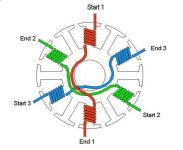Hi All,
Does anyone know where to look to get technical info on the ins-and-outs of windings? I understand magnetic flux density and all that but I'm looking for something that formulaic for, say, take a motor that is configured as "such and such" and if I wind it at , oh, 10T then I will need wire gauge X, with an R of x Ohms and the K value will be blah blah and so on.
-Cheers.
Does anyone know where to look to get technical info on the ins-and-outs of windings? I understand magnetic flux density and all that but I'm looking for something that formulaic for, say, take a motor that is configured as "such and such" and if I wind it at , oh, 10T then I will need wire gauge X, with an R of x Ohms and the K value will be blah blah and so on.
-Cheers.


